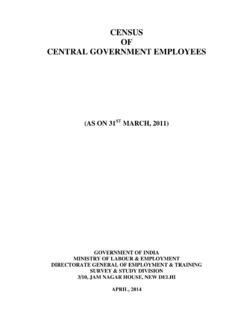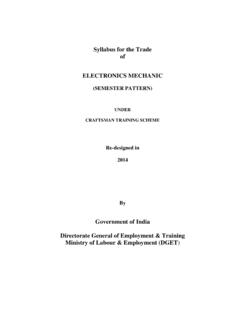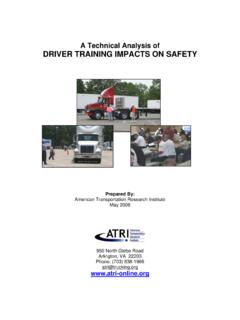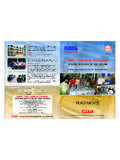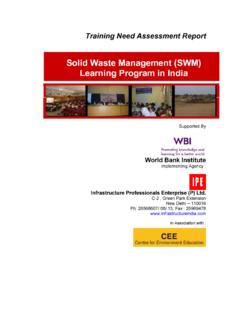Transcription of “Training Methodology (TM) Under Craft …
1 1 Syllabus for the subject of training Methodology (TM) Under Craft instructor training Scheme (CITS) Re- Designed in - 2014 Designed by: Government of India Ministry of Labour & Employment Directorate General of Employment and training central STAFF training AND RESEARCH institute EN Block, Sector V, Salt Lake City, Kolkata 700 091 2 CONTENTS SECTION DESCRIPTION PAGE NO. A Rationale 3 B General Information 4 C Semester wise Allotment of Time & Marks among the Subjects 5 D Details of Syllabus 6 E List of Tools & Equipments 17 F List of Expert Members 18 3 A. RATIONALE The economic prosperity and pace of development of a nation depend upon the development of human resources of that nation.
2 The significant fact in the development of human resources refers to the level of competencies and the factors responsible for efficient delivery of these competencies. It largely depends on those who develop these competencies. Therefore, for this purpose highly competent instructors for imparting these competencies are need of Hour. Instructors imparting these competencies should have the capability to perform efficiently too. For this, Capacity Building of Instructors is crucial. Objectives: 1. To equip the Instructors and prospective instructors with requisite knowledge and skill in instructional technology. 2. To make them competent to impart skill Under various schemes of DGE&T based on sound pedagogical principles and concept.
3 3. To develop the competencies of the Instructors and prospective instructors in preparation and utilization of teaching aids and handling of visual and audio visual equipments supported by Information and Communication Technology (ICT). 4 A. GENERAL INFORMATION 1. Name of the Course : Craft instructor training 2. Duration of instructor training : 1 Year (Two semesters each of six months duration). 3. Subjects covered in the Semesters : Detailed in Section - C 4. Name of the Subject : training Methodology 5.
4 Applicability : ALL TRADES to be imparted in the second semester 6. Examination : AITT to be held at the end of the semester. 7. Space Norms : (a) One class room of minimum 30 area having minimum width of 5 with Illumination of 6000 lumen (b) Audio Visual Lab : 120 sq. meter having minimum width of 8 m.
5 And with Illumination of 30000 lumen The electrical equipments of Class room should conform to minimum 3 star Building energy rating as per Bureau of Energy Efficiency ( ) 8.
6 Power Norms : (a) 1 KW for Class room (b) 10 KW for Lab. 9. Unit strength(Batch Size) : 20 10. Entry qualification : Diploma/Degree in appropriate branch of Engineering from AICTE recognized Board / University commensurate with intended trade OR Completed Semester I of any trade Under CITS 11.
7 Trainers Qualification : Graduate from AICTE recognized University with two years experience 12. Desirable: Passed National Craft instructor training course in same or relevant trade.. In case of two units, one trainer must be Degree in Engineering. 5 B. SEMESTER WISE ALLOTMENT OF TIME & MARKS AMONG THE SUBJECTS FOR CITS SUBJECTS Hrs. / Week % of time allotted Marks Sessional Full Marks Pass Marks Exam.
8 Sessional Total First semester Trade Practical 1 20 50 200 30 230 120 18 138 Trade Theory - 1 6 15 100 20 120 60 12 72 Workshop Cal. & Sc. 6 15 50 - 50 30 - 30 Engineering Drawing 6 15 100 - 100 60 - 60 Library 2 5 - - TOTAL for Sem. - I 40 450 50 500 270 30 300 Second semester Trade Practical 2 16 40 200 30 230 120 18 138 Trade Theory - 2 4 10 100 20 120 60 12 72 training Methodology - Practical 12 30 200 30 230 120 18 138 training Methodology - Theory + IT 6+2 20 100 20 120 60 12 72 TOTAL 40 600 100 700 360 60 420 GRAND TOTAL 80 1050 150 1200 630 90 720 Hourly Distribution TOTAL: 1200 marks for 2 semesters Pass marks.
9 720 Time in % Marks in % Trade Practical 45 38 Trade Theory 20 Total for Trade 58 training Methodology (Practical) 15 19 training Methodology (Theory) + IT 10 Total for training Methodology & IT 29 Engineering Drawing 12 Workshop Cal. & Sc. 4 Library - 6 C. RE-DESIGNED SYLLABUS FOR THE SUBJECT: training Methodology Craft instructor training SCHEME Note: During the discussion of any machine tools, related precautions and safety measures should be discussed. Trade Theory Trade Practical Unit No. Topics Hours Marks Topics Hours Marks I Roles and Responsibilities of an instructor 18 Roles and Responsibilities of an instructor 27 II Psychology of Learning 15 Psychology of Learning 21 III Analysis of Syllabus and Course Construction 12 Analysis of Syllabus and Course Construction 18 IV Planning for Instruction 15 Planning for Instruction 24 V Instructional Technology 15 Instructional Technology 33 VI Written Instructional Materials 18 Written Instructional Materials 27 VII Assessment and Certification 15 Assessment and Certification 21 VIII Organization and Management of Instructional Functions 15
10 Organization and Management of Instructional Functions 21 IX Counseling & Mentoring 12 Counseling & Mentoring 20 X Distance Learning Programme 15 Distance Learning Programme 21 XI Entrepreneurship Development 15 Entrepreneurship Development 24 XII ICT and Internet 11 ICT and Internet 17 TOTAL - 176 264 One session = Hrs. One session = 3 Hrs. 7 D. Syllabus for the Subject of training Methodology Under Craft instructor training Scheme (CITS) Unit instructor : Roles & Responsibilities of an instructor (09 sessions) Lesson No. Theory Practical Introduction Overview on elements of vocational training - by trainer Orientation What kind of Learner are you - Questionnaire to be answered by Trainees Skill Development programmes of DGET Current Status What do you already know about training procedures - Questionnaire - By Trainees Teaching Vs Trainer/Teacher Video show of a teacher given a classroom lecture to the students and a trainer given a demonstration to the trainees Difference between Vocational Education and Vocational training Conduct a group discussion among the trainees about the topic Principles of Vocational
